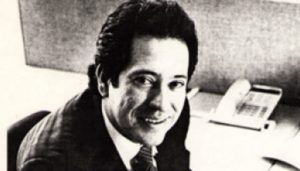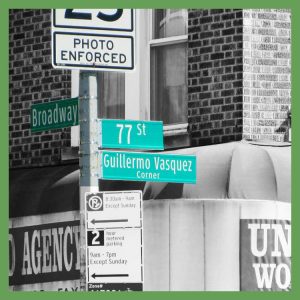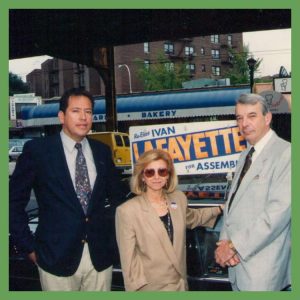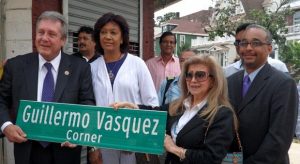LGBT history mapped as another Queens site is published
20180814
FOR IMMEDIATE RELEASE
PRESS CONTACT
Ken Lustbader, NYC LGBT Historic Sites Project
p: (917) 848-1776 / e: [email protected]
Guillermo Vasquez Corner is latest Queens LGBT
site featured on dynamic digital map
Corner of 77th Street and Broadway, in Elmhurst, honors Colombian-born
Queens resident who helped co-found annual Queens Pride march
New York, NY—The NYC LGBT Historic Sites Project announces the digital publication of its latest Queens-based site significant to the City’s LGBT history: Guillermo Vasquez Corner, in Elmhurst. This latest historic site brings the total of sites in Queens up to nine, with many more in the queue for further research and publication in late Summer/early Fall.
Guillermo Vasquez was a leading gay rights, AIDS, and Latino community activist in Queens who emigrated from Colombia in 1972. Seventeen years after his 1996 death from AIDS-related complications, the corner of 77th Street and Broadway was renamed “Guillermo Vasquez Corner” and a street sign was unveiled next to the site of the Love Boat, a former gay Latino bar where Vasquez educated the community about HIV/AIDS.

NYC Councilmember Daniel Dromm, Chair of the Council’s LGBT Caucus, recalls of the impact Guillermo Vasquez made on his Queens and Latino communities: “He was a fierce soldier in the battle against HIV/AIDS and a bridge between Latino activists and other movements for social justice.”


Other significant LGBT sites in Queens already published to the Project’s interactive map include:
- Bum Bum Bar (more)
- West Side Tennis Club (more)
- Frank Kameny Residence (more)
- Kitty Genovese Residence (more)
- Julio Rivera Corner (more)
- New York State Pavilion (more)
- Riis Park Beach (more)
- Manford Family Residence (more)
 Photos:
Photos:
(1) Guillermo Vasquez.
(2, left) Guillermo Vasquez Corner street sign in front of the building that once housed the Love Boat, a gay Latino bar where Vasquez educated the community about HIV/AIDS, 2018. Photo by Amanda Davis/NYC LGBT Historic Sites Project.
(3, right) Guillermo Vasquez (at left), Nayibe Nunez-Berger and New York State Assembly representative Ivan Lafayette on Roosevelt Avenue in Jackson Heights, c. 1990s. Courtesy of NYC Council Member Daniel Dromm.
(4) NYC Council Member Daniel Dromm and Nayibe Nunez-Berger, president of the Latin American Cultural Center of Queens, hold the Guillermo Vasquez Corner sign at the July 27, 2013 street co-naming ceremony. State Senator José Peralta is at right. Photo by Ana Luisa Castaño, via Queens Latino.
Historical Background
Born near Cali, Colombia, Guillermo Vasquez (1953-1996) immigrated to the United States in 1972 to study international law and political science at Pace and Columbia universities. A long-time resident of Jackson Heights, Queens, Vasquez was a leading advocate for the borough’s Latino community. He was a founding member and president of the Queens Hispanic Coalition, a founding member of the Latin American Cultural Center of Queens, and a member of the Colombian American National Coalition.
Vasquez was also instrumental in pushing for LGBT visibility in Queens and raising awareness—especially among Latinos—about the AIDS epidemic. Vasquez was a member of Queens Gays and Lesbians United (Q-GLU), worked with the New York City Gay and Lesbian Anti-Violence Project (now the Anti-Violence Project), and served on the board of the Empire State Pride Agenda, a statewide organization that advocated for LGBT rights. In 1993, as a member of the Queens Lesbian and Gay Pride Committee, he helped organize the first Queens Pride Parade and served as a translator for Spanish-speaking participants. (more)
As sites connected to LGBT history in NYC are threatened — the former site of the Paradise Garage has been demolished; 69 West 14th Street, site of the founding of the Gay Liberation Front, is actively threatened by the wrecking ball — it is more important than ever to remember the determination of LGBT equal rights pioneers and the physical sites which place key people and events in history.
About the NYC LGBT Historic Sites Project
The NYC LGBT Historic Sites Project is a cultural initiative and educational resource that is documenting historic sites connected to the LGBT community throughout New York City. Its interactive map features diverse places from the 17th century to the year 2000 that are important to LGBT history and illustrate the community’s influence on American culture. The Project is nominating sites to the National Register of Historic Places and developing educational tours and programs.
###